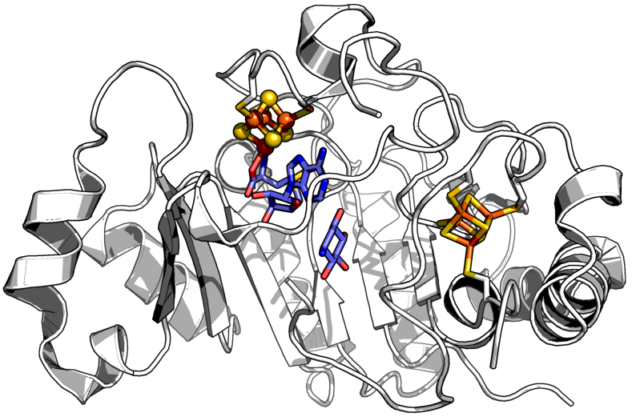AdoMet Radical Enzymes

Redox enzymes can catalyze a startling array of transformations. This truism is perfectly exemplified by the AdoMet Radical Enzyme (ARE) Superfamily: a group of over 100,000 enzymes that are capable of catalyzing many different kinds of chemistry (C-C bond forming reactions, oxidations, epimerizations, ring-closures, sulfur-insertions, and many more), yet share common features at their core. Canonically, the AREs all make use of a [Fe4S4] cluster that reductively cleaves S-Adenosyl-Methonine in order to transiently produce an adenosyl radical (Ado•), which then performs the next step of chemistry. Remarkably, the ARE Superfamily are also marked by members that possess multiple other iron-sulfur clusters. In this project, we work closely with a series of collaborating research groups to understand how the redox properties of the different AREs are different, why some of them contain additional iron-sulfur clusters, and how Nature tunes the redox potentials of the FeS clusters themselves. We have found that some of these enzymes possess ‘auxiliary’ [Fe4S4] clusters of surprisingly low potential (~ -700 mV), and we now poised to understand how such low-potential clusters appear to be essential to the chemistry of the ARE Superfamily. This work is supported by the National Institutes of Health (NIGMS), through grant R01-GM120283.
Representative publications
1. Maiocco SJ, Arcinas A, Landgraf B, Lee K-H, Booker SJ, Elliott SJ, “Transformations of the FeS clusters of the methylthiotransferases MiaB and RimO, detected by direct electrochemistry,” Biochemistry, 2016, 55(39), 5531-5536. [DOI]
2. Blaszczyk AJ, Silakov A, Zhang B, Maiocco SJ, Lanz ND, Kelly WL, Elliott SJ, Krebs C, Booker SJ. “Spectroscopic and Electrochemical Characterization of the Iron-Sulfur and Cobalamin Cofactors of TsrM, an Unusual Radical S-Adenosylmethionine Methylase”, J. Am. Chem. Soc. 2016, 138(10), 3416-3426. [DOI]
3. Maiocco SJ, Grove TL, Booker SJ, Elliott SJ. “Electrochemical Resolution of the [4Fe-4S] Centers of the AdoMet Radical Enzyme BtrN: Evidence of Proton Coupling and an Unusual, Low- Potential Auxiliary Cluster,” J. Am. Chem. Soc. , 2015, 127(37): 8664-8667. [DOI]